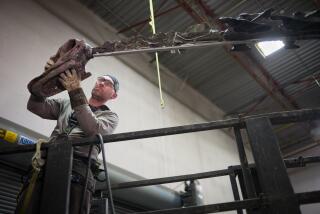Dance of the dinosaurs? Strange gouges hint at bird-like mating rituals
That old saying about the birds and the bees might have to include dinosaurs now, too. Giant scrapes carved into sandstone sites in Colorado were left by amorous dinosaurs looking to impress potential mates, according to an international team of scientists.
The findings, described in Scientific Reports, offer a rare window into the courtship behavior of these extinct animals -- and provide physical evidence that some dinosaurs may have acted much like birds, their modern-day relatives.
Dinosaurs were wiped out entirely after an asteroid smashed into Earth some 66 million years ago, and so our understanding of them comes mostly in the form of fossils, typically bones. Skeletal remnants allow researchers to piece together much of what these animals looked like and even some of their behavior -- what they ate, how they walked, whether they fought. Fossil footprints and other markings can also offer insight into their habits; trackways in British Columbia, Canada, for example, have shown that tyrannosaurs may have hunted in groups rather than solo.
Still, little has been known about dinosaurs’ mating behaviors; many researchers figured that dinosaur mating displays may have looked a lot like those of birds, in which males often use impressive plumage or complex dances to impress a mate. (Think of iridescent peacock feathers, for example.) After all, birds are thought to be the living descendants of dinosaurs. The problem is, there’s little direct evidence to back these ideas up.
“Despite extensive phylogenetic and morphological support, behavioral evidence is mostly ambiguous and does not usually fossilize,” Martin Lockley of the University of Colorado, Denver, and his co-authors wrote. “Thus, inferences that dinosaurs, especially theropods, displayed behavior analogous to modern birds are intriguing but speculative.”
The tracks discovered in the Dakota Sandstone of Colorado, three sites in the western part of the state and one in the east, start to sketch out what that mating process may have looked like. The largest of the sites had about 60 scrapes on one sandstone surface that was roughly 50 meters long and 15 meters wide. Such sites may have served as leks, or display arenas, where males might gather in large groups to show off to the ladies.
“The size, depth and distribution of these scrapes is variable,” the study authors wrote. “However, most typically consist of parallel double troughs, comprised of multiple scrapes separated by a raised central ridge. ... A few show complete outlines of three-toed theropod tracks, and some show thin aprons of excavated sediment aligned with the long axis of the scrapes.”
These gouges were likely “nest scrape displays,” when the males would dig deeply into the dirt to show off their nest-making abilities. (Once they’d found a mate, the actual nests would probably have been built elsewhere.)
The double-furrow markings actually bear a striking resemblance to those left by Atlantic puffins shortly before breeding. Ostriches, the largest living birds, are thought to leave similar tracks, although they typically nest in the scrapes, leaving little trace of the original markings.
“These scrapes can be interpreted as the missing physical evidence which indicates that non-avian theropods engaged in stereotypical avian courtship and lek-like behaviors, which were previously only a matter of speculation among paleobiologists,” the authors wrote.
Follow @aminawrite on Twitter for more science news and “like” Los Angeles Times Science & Health on Facebook.







